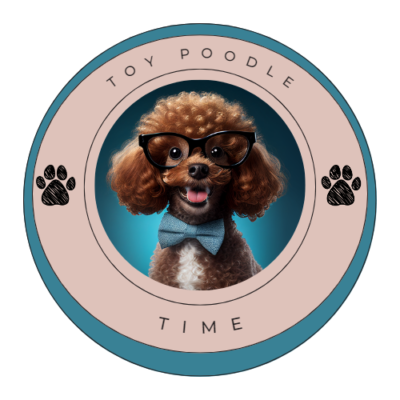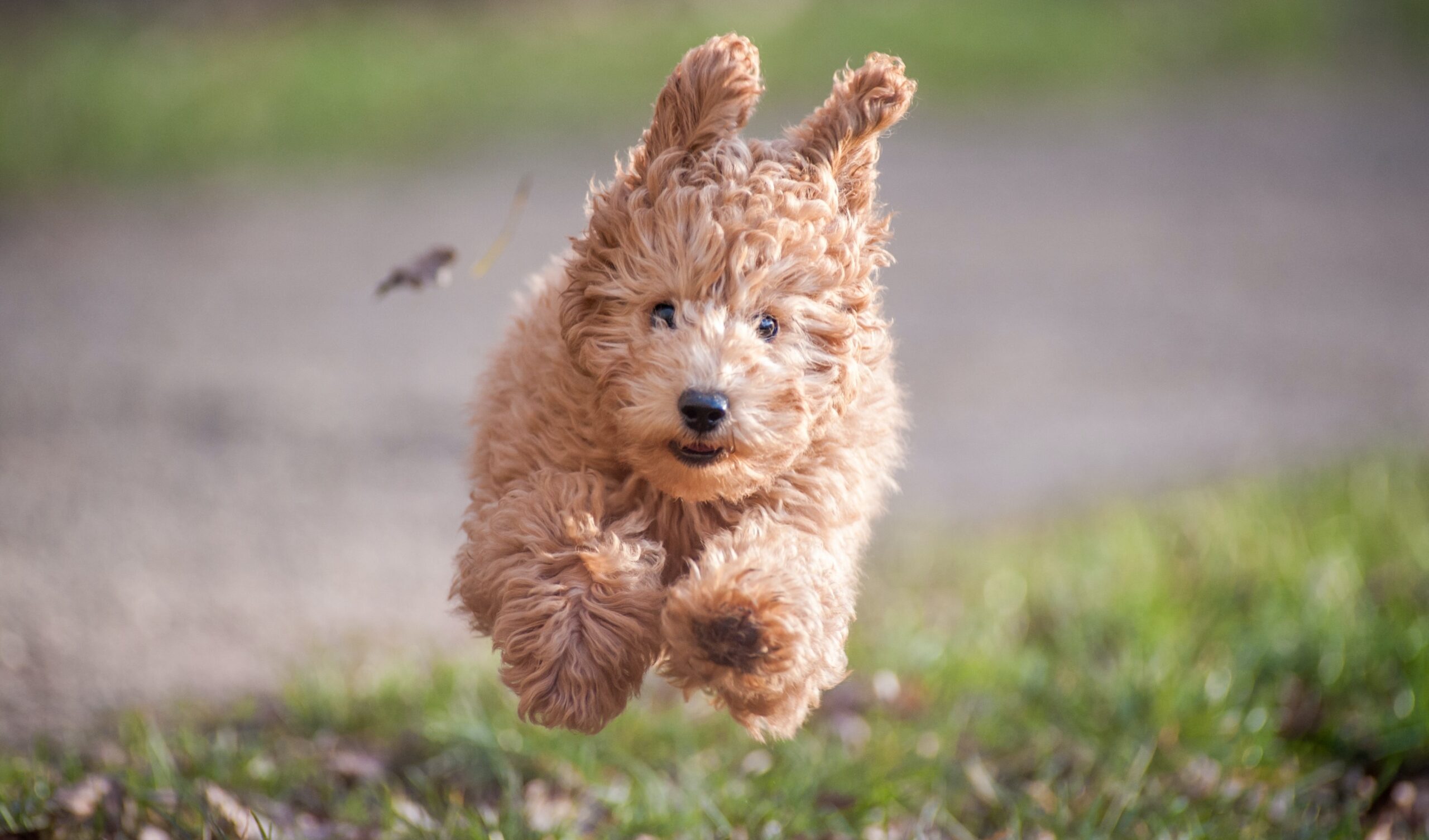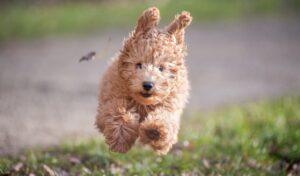 Have you ever noticed your dog skip a step when he’s running, like he’s running on three legs for a moment, then back to four? Or does your dog occasionally bunny hop, picking both back legs off the ground for a step? My little Toy, Fred, will sometimes stretch his leg straight backward, like there is some kind of glitch in his system, then trots off like nothing happened. If you’ve noticed a change in your dog’s stride or any of these abnormal behaviors, they may have a luxating patella. So, what is a luxating patella in dogs?
Have you ever noticed your dog skip a step when he’s running, like he’s running on three legs for a moment, then back to four? Or does your dog occasionally bunny hop, picking both back legs off the ground for a step? My little Toy, Fred, will sometimes stretch his leg straight backward, like there is some kind of glitch in his system, then trots off like nothing happened. If you’ve noticed a change in your dog’s stride or any of these abnormal behaviors, they may have a luxating patella. So, what is a luxating patella in dogs?
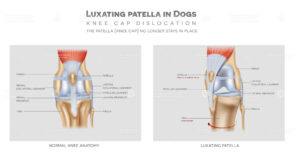 What is a Luxating Patella?
What is a Luxating Patella?
Luxating means to dislocate, and patella is kneecap, so a luxating patella is just a way of saying your dog’s knee pops out of joint. Like our knees, your dog’s knee has several parts that work together to produce normal movement. The patella normally sits in a groove (trochlear groove) at the end of the femur. One portion of the patella is attached to the quadriceps tendon, which in turn is attached to large quad muscles. The other portion is attached to the patellar ligament, which in turn is attached to a point on the front and center of the tibia (shin bone). When the quad muscles contract or relax, this slides the kneecap smoothly within the groove to bend or extend the leg, like a pulley system. Dislocation occurs when the kneecap has come out of that groove. The skip, hopping, or stretching you see your dog doing is him trying to move the kneecap back into that groove. In severe cases, your dog may appear bow-legged or knock-kneed. Over time, continued dislocation leads to wear and tear on the sides of the groove, osteoarthritis, pain, lameness (inability to use the affected leg), and stress on the cranial cruciate ligament (CCL, or ACL in humans). Patellar luxation is one of the major causes of hind leg lameness and early onset osteoarthritis in the knee area.
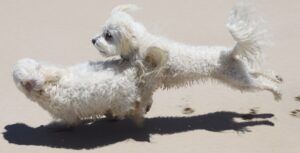 What Breeds are Affected by a Luxating Patella?
What Breeds are Affected by a Luxating Patella?
Any dog can have a luxating patella, it is one of, if not the most common orthopedic problem seen in dogs. While not as common in large dogs, there are a several large breeds, like Shar Pei, Akita, and Great Pyrenees now predisposed to this condition. Luxating patellas are much more prevalent in small and toy breeds such as Chihuahuas, Bichon Frises, Pomeranians, Lhasa Apsos, Yorkshire Terriers, and Toy Poodles. Toy Poodles seem to be more predisposed to luxating patellas than other breeds.
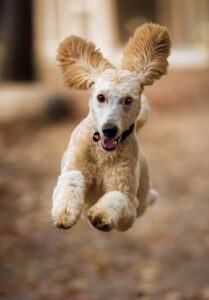 Causes
Causes
The most common cause for a luxating patella is congenital. That is not to say a dog is born with a luxating patella, but rather born with anatomic abnormalities that cause a luxating patella. The trochlear groove the patella sits in may not be deep enough allowing for easy slippage. The patellar ligament may be attached not at the front and center of the tibia, but off to the side causing misalignment. Surrounding soft tissues and ligaments that make up the knee joint and help keep the kneecap in place may be too tight or too loose causing the kneecap to dislocate. A luxating patella may be caused by one or a combination of these abnormalities. A traumatic injury such as a fall, jump, or accident involving a dog’s hind legs can also cause a luxating patella.
Diagnosis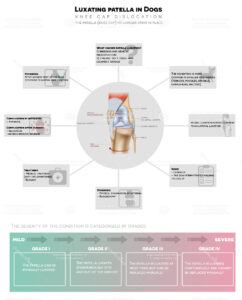
Symptoms of patellar luxation start early; most dogs being diagnosed by time they are 3 years old. Early diagnosis is essential to prevent further joint changes and deterioration. Your vet will perform a physical exam including gait evaluation, range of motion and manipulation of your pet’s hind legs focusing on your dog’s patellar instability. The vet will also take x-rays looking for any skeletal deformities or degenerative changes to hind leg bones. Once your vet has examined your pup, they will assign a grade depending on the degree of luxation. There are several grading systems, but the most common grades patellar luxation on a scale of I-IV, IV being the most severe.
Grade I – The patella can be moved out of the groove (luxated) when pressure is applied but moves right back into place once pressure is released.
Grade II – The patella moves out of the groove when pressure is applied or on its own and will remain out until your dog’s leg is hyperextended and rotated helping the patella return to the groove.
Grade III – The patella remains out of the groove most of the time but can be manually put back in place. However, it will just luxate again.
Grade IV – The patella is permanently out of the groove and cannot be manually put back in place.
Treatment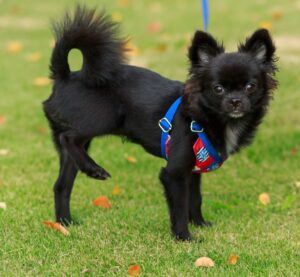
Treatment really depends on the grade of luxation. Most Grades I and II do well with a more conservative approach. In fact, many dogs live their whole lives with a Grade I, never progressing to a Grade II. Early treatment can help delay or even prevent further deterioration. For some though, the wear and tear of a Grade I or II will lead to osteoarthritis, decreased mobility, and joint pain, but conservative treatments can help alleviate some of the pain and discomfort associated with a luxating patella. Surgery is typically reserved for Grades III and IV, but some Grade II should be considered if your dog is having increased pain and lameness from tissue damage. You and your vet should discuss the best course of action for your pup. Some conservative treatments your vet may suggest are:
Weight management – Excess weight puts additional stress on weight-bearing joints (like your dog’s knees). A healthy weight and diet mean healthier joints.
Joint supplements – Supplements like glucosamine and chondroitin may help alleviate joint symptoms caused by osteoarthritis.
Anti-inflammatories – NSAIDs help control pain and inflammation associated with osteoarthritis.
Physical therapy – Helps to rebuild muscle strength and tone, strengthening the knee area.
Pain medication – For pain due to osteoarthritis.
Exercise restrictions – Your vet may place exercise restrictions on your dog such as no running or jumping.
Massage and hydrotherapy – Promotes wellness and comfort.
Surgery by an orthopedic specialist should be performed if your dog’s pain is no longer controlled with more conservative therapies, persistent lameness or other injuries have occurred due to luxation (patellar luxation predisposes your dog to other injuries like cruciate ligament tear or rupture). There are several different techniques used to repair a luxating patella, but the primary aim is to restore normal alignment. The success rate for patellar surgery in dogs is about 90% with most returning to full limb function.
Things You Can Do to Help Your Pet
We all want what’s best for our wonderful companions and helping in even the smallest way can make a huge difference in their lives. Some things you can do at home are:
Short daily walks to help keep muscles strong and joints limber
Plenty of rest and relaxation and petting (my Toy Fred wanted me to add this tip)
Minimal access to stairs
Cover slick floors with area rugs to decrease slipping
Discourage running
Discourage jumping off the bed or couch by placing pet steps or a pet ramp
Frequent paw pad shaving will decrease slipping on slick floors
Conclusion
A luxating patella in dogs is a pretty common condition, especially among small dogs like Toy Poodles. It can be painful and debilitating when their knee dislocates. Recognizing signs like changes in your dog’s gait, bunny hopping, or skipping, and getting your pup to the vet early for a thorough check-up are the first steps toward successful treatment. Starting conservative treatments early can help your pup live a long, happy, pain-free life.
